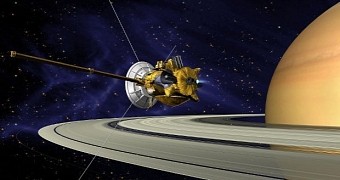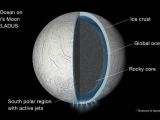A couple of weeks ago, on October 14, NASA's Cassini spacecraft successfully completed a flyby of Saturn's moon Enceladus and came within about 1,142 miles (1,839 kilometers) of the orb's surface.
Then, this past Thursday, the agency sent the spacecraft to have an even closer look at the celestial body. As detailed in NASA's Astrobiology Magazine, Cassini got as close as 30 miles (49 kilometers) of the moon's surface and even probed one of the icy fountains stemming from its south pole.
Cassini completed this flyby to search for signs of habitability
Earlier this year, it was announced that Saturn's moon Enceladus most likely hides a mammoth ocean under its crust. What researchers are now trying to figure out is whether this ocean could possibly be habitable, maybe even house alien lifeforms already.
As mentioned, Cassini's latest flyby of the orb brought the spacecraft within 30 miles (49 kilometers) of its target's surface and allowed it to sample an icy plume stemming from its south pole.
Mission scientists haven't yet gotten around to downloading and analyzing all the data, but they are hopeful that, in a few weeks' time, they'll be able to say whether the hidden ocean lurking on Enceladus is life-friendly or, quite the contrary, a hostile environment.
“Cassini's instruments do not have the capability to detect life itself. Those instruments can, however, make powerful measurements about the ocean and its potential habitability,” researcher Linda Spilker explained in an interview.
For one thing, NASA scientists wish to establish if the ocean hidden on this moon of Saturn is made up of water, known to be indispensable to the emergence of life, or some other compound. Then, they hope to zoom in on organic molecules, known to be the building blocks of life.
Mind you, there's another mystery that needs solving
The reason scientists are quite convinced there is an ocean lurking on Enceladus is because of dozens of geysers observed over the years springing out of the moon's south pole. These icy fountains must be fueled by something, and the best guess is a concealed ocean.
The thing is that, at least for now, researchers can't say for sure how this ocean came into being. They suspect tidal heating resulting from gravitational interactions with nearby celestial bodies had a say in the matter, but studies suggest other processes were also at play.
Thus, it is believed that there might be hydrothermal activity happening deep inside the moon and that this helped form the ocean. If this is indeed the case, there's an even greater chance that Enceladus might be habitable, seeing as how hydrothermal activity is known to sustain microbial life.

 14 DAY TRIAL //
14 DAY TRIAL // 

